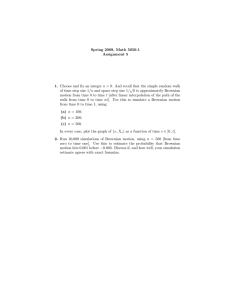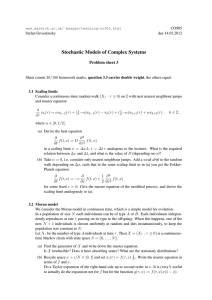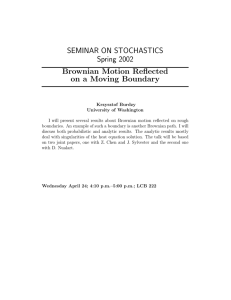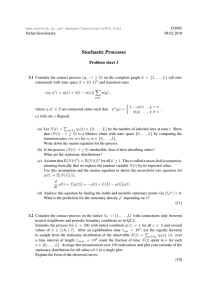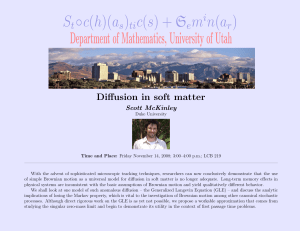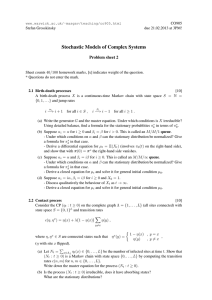Stochastic Models of Complex Systems Problem sheet 3
advertisement
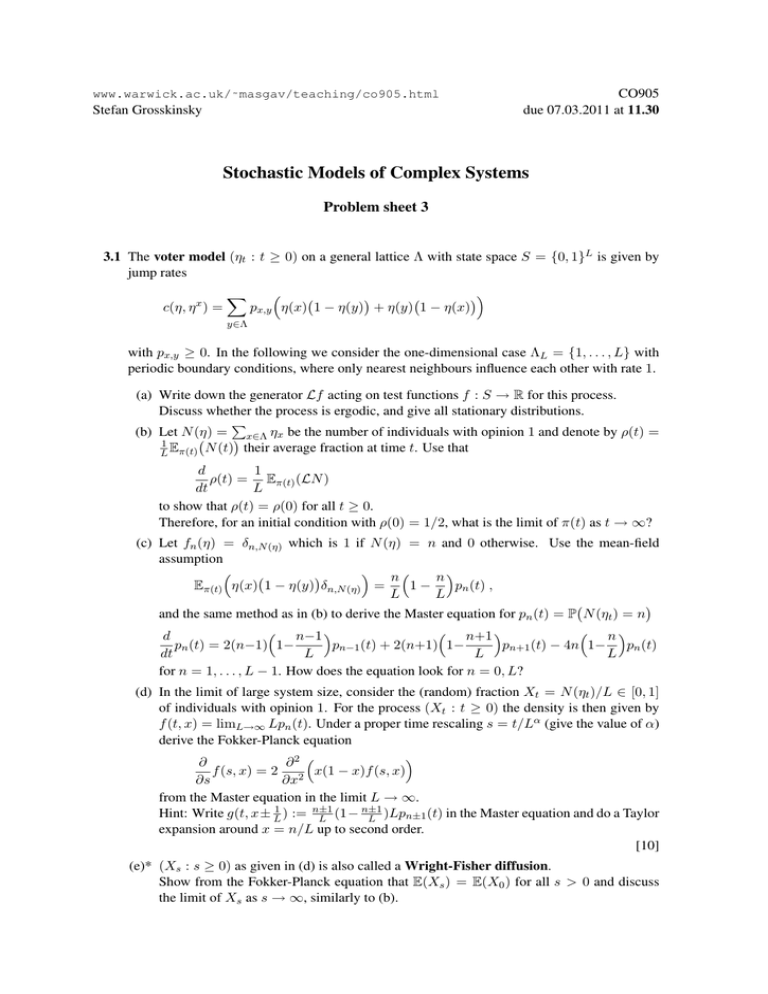
www.warwick.ac.uk/˜masgav/teaching/co905.html
Stefan Grosskinsky
CO905
due 07.03.2011 at 11.30
Stochastic Models of Complex Systems
Problem sheet 3
3.1 The voter model (ηt : t ≥ 0) on a general lattice Λ with state space S = {0, 1}L is given by
jump rates
c(η, η x ) =
X
px,y η(x) 1 − η(y) + η(y) 1 − η(x)
y∈Λ
with px,y ≥ 0. In the following we consider the one-dimensional case ΛL = {1, . . . , L} with
periodic boundary conditions, where only nearest neighbours influence each other with rate 1.
(a) Write down the generator Lf acting on test functions f : S → R for this process.
Discuss whether the process is ergodic, and give all stationary distributions.
P
(b) Let N (η) = x∈Λ ηx be the number of individuals with opinion 1 and denote by ρ(t) =
1
L Eπ(t) N (t) their average fraction at time t. Use that
d
1
ρ(t) = Eπ(t) (LN )
dt
L
to show that ρ(t) = ρ(0) for all t ≥ 0.
Therefore, for an initial condition with ρ(0) = 1/2, what is the limit of π(t) as t → ∞?
(c) Let fn (η) = δn,N (η) which is 1 if N (η) = n and 0 otherwise. Use the mean-field
assumption
n
n
1−
pn (t) ,
Eπ(t) η(x) 1 − η(y) δn,N (η) =
L
L
and the same method as in (b) to derive the Master equation for pn (t) = P N (ηt ) = n
n−1 n+1 n
d
pn (t) = 2(n−1) 1−
pn−1 (t) + 2(n+1) 1−
pn+1 (t) − 4n 1− pn (t)
dt
L
L
L
for n = 1, . . . , L − 1. How does the equation look for n = 0, L?
(d) In the limit of large system size, consider the (random) fraction Xt = N (ηt )/L ∈ [0, 1]
of individuals with opinion 1. For the process (Xt : t ≥ 0) the density is then given by
f (t, x) = limL→∞ Lpn (t). Under a proper time rescaling s = t/Lα (give the value of α)
derive the Fokker-Planck equation
∂
∂2 f (s, x) = 2 2 x(1 − x)f (s, x)
∂s
∂x
from the Master equation in the limit L → ∞.
n±1
Hint: Write g(t, x± L1 ) := n±1
L (1− L )Lpn±1 (t) in the Master equation and do a Taylor
expansion around x = n/L up to second order.
[10]
(e)* (Xs : s ≥ 0) as given in (d) is also called a Wright-Fisher diffusion.
Show from the Fokker-Planck equation that E(Xs ) = E(X0 ) for all s > 0 and discuss
the limit of Xs as s → ∞, similarly to (b).
3.2 Let X = (Xn : n ∈ N) be a simple random walk on Z with transition probabilities
pi,i+1 = 1/2 + ,
pi,i−1 = 1/2 − for all i ∈ Z .
Rescale time t = ∆t n and derive the Fokker-Planck equation for an appropriate scaling of
space and , analogous to the derivation of Section 2.1. What is the right scaling of the asymmetry (∆t) to get a limit with non-zero drift and diffusion?
[4]
3.3
(a) Let ξ ∼ N (0, 1) be a Gaussian random variable with
√ mean 0 and variance 1. Then
consider the continuous time stochastic process Xt = tξ. Show that Xt ∼ N (0, t).
Is X a Brownian motion? (Justify your answer.)
(b) Let B and B̃ be a two independent standard Brownian
motions in R and ρ ∈ [−1, 1] a
p
constant. Then consider the process Xt = ρBt + 1 − ρ2 B̃t .
Show that X is again a standard Brownian motion. (Hint: use covariances)
[4]
(c)* Let B be a Brownian motion. What is the distribution of Bs + Bt for 0 ≤ s ≤ t?
(d)* Scaling property: Let B be a standard Brownian motion in Rd . Show that for λ > 0,
Bλ = λ−1/2 Bλt : t ≥ 0 is a standard Brownian motion in Rd .
3.4 Consider the contact process (ηt : t ≥ 0) as defined in Q2.2, but now on the one-dimensional
lattice ΛL = {1, . . . , L} with connections only between nearest neighbours and periodic boundary conditions.
The critical value λc is defined such that the infection on the infinite lattice Λ = Z started from
the fully infected lattice dies out for λ < λc , and survives for λ > λc . It is known numerically
up to several digits, depends on the dimension, and lies in the interval [1, 2] in our case.
(a) Simulate the process with initial condition η(x) = 1 for allPx ∈ Λ and several values of
λ ∈ [1, 2]. Plot the number of infected individuals Nt = x∈ΛL ηt (x) as a function of
time averaging over 100 realizations in a double-logarithmic plot.
What is the expected behaviour of Nt depending on λ for times up to order L?
For a given system size L, find the window of interest choosing λ = 1, 1.2, . . . , 1.8, 2 and
then use increments 0.01 for λ to find an estimate of the critical value λc (L) ∈ [1, 2].
Repeat this for different lattice sizes, e.g. L = 64, 128, 256, 512, and plot your estimates
of λc (L) against 1/L. Extrapolate to 1/L → 0 to get an estimate of λc = λc (∞).
This approach is called finite size scaling, in order to correct for finite size effects which
influence the critical value.
[12]
(b) Simulate the process for L = 128 with initial condition η(x) = 1 for all x ∈ Λ and several
(at least 3) values of λ around λc (L). After an equilibration
time τequ = L, sample from
P
the distribution of the number of infections Nt = x∈ΛL ηt (x), i.e. over a time interval
of length τmeas = L count the fraction of time Nt spent in n for each n ∈ {0, . . . , L}.
Average this measurement over 100 realizations and plot your estimate of the distribution
for all values of λ in a single plot (it might be a good idea to use a log-scale on the y axis).
Explain the form of the observed curves.
[6]
(c)* Repeat the analysis of (a) on the fully connected graph ΛL , and compare your estimate of
λc with the mean-field prediction from Q2.2.
